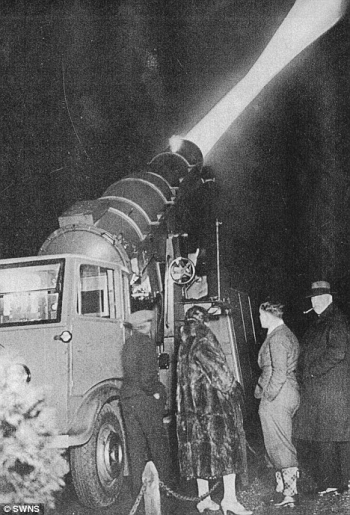|
Today in New Orleans History |
|
|
December 14


The Sky Projector Comes to Town After the run at Holmes,
the National Sky Projector Company of New York planned to move the Sky Projector to other neighborhoods around the city. Charles
Margolis of the Sky Projector Company of New York and Chicago predicted that motion pictures on clouds would be a reality
"within a short time" using a similar apparatus.
Some claim that the "Bat Signal" was based on the Sky Projector's brief bout with fame. And one begs to wonder if motion
picture drive-ins weren't a spin-off of the invention. Photo from www.dailymail.co.uk
The Sky Projector was the brainchild of Englishman Harry Grindell Matthews, who has also been credited with inventing the world's first mobile phone, automatic guidance of planes (auto pilot), submarine detection, aerial defense systems, a "Death Ray", and more.
|
||
|
MV Bright Field was a bulk cargo ship which allided with the Riverwalk
Marketplace shopping complex in New Orleans, Louisiana, on the afternoon of Saturday, December
14, 1996, after losing engine power. The vessel was fully loaded with grain at the time of the incident. The United
States Coast Guard investigated the incident and published its findings on December 8, 1997, citing the cause of
the engine failure as a poorly maintained oil filter. A secondary but contributory cause was determined as a
main-engine automation system which produced warnings and alarms that were not consistently relayed to the ship's Master.
The National Transportation Safety Board published its final report on January 13, 1998, which concurred with
the Coast Guard's determinations and appear to charge the ship's operating company with the responsibility for the casualty.
The incident resulted in no deaths, but 66 persons were injured. Physical damage to the Bright Field was calculated at $1,857,952.
Damage to the Riverwalk, including the pier, condominium properties, shops and hotel, totaled an estimated $15 million.
From wikipedia.
|
|
|
|

To receive an update for each day in New Orleans history,
join our facebook page - Today in New
Orleans History.
Analytics |
||

 On December 14, 1935 at 5:30 p.m., a $60,000 Sky Projector ("the only apparatus of its kind in the world"
according to local publications) shot images of Santa Claus at the North Pole as well as Christmas text greetings (called
"Sky Grams") onto the clouds from the front of the D.H. Holmes building on Canal Street. Its 400,000,000 candle-power
beam was brought to the city courtesy of Holmes in conjunction with their Christmas adverstising campaign. The demonstration
would continue nightly from 5:30 to !0:00 until Christmas Day. If the clouds failed to show, the Sky Projector would
cast its beam on nearby buildings. Made from a powerful arc lamp, focusing lens and a plane mirror the Sky Projector would
project an image high into the sky without the need for a screen to project the image onto.
On December 14, 1935 at 5:30 p.m., a $60,000 Sky Projector ("the only apparatus of its kind in the world"
according to local publications) shot images of Santa Claus at the North Pole as well as Christmas text greetings (called
"Sky Grams") onto the clouds from the front of the D.H. Holmes building on Canal Street. Its 400,000,000 candle-power
beam was brought to the city courtesy of Holmes in conjunction with their Christmas adverstising campaign. The demonstration
would continue nightly from 5:30 to !0:00 until Christmas Day. If the clouds failed to show, the Sky Projector would
cast its beam on nearby buildings. Made from a powerful arc lamp, focusing lens and a plane mirror the Sky Projector would
project an image high into the sky without the need for a screen to project the image onto.





